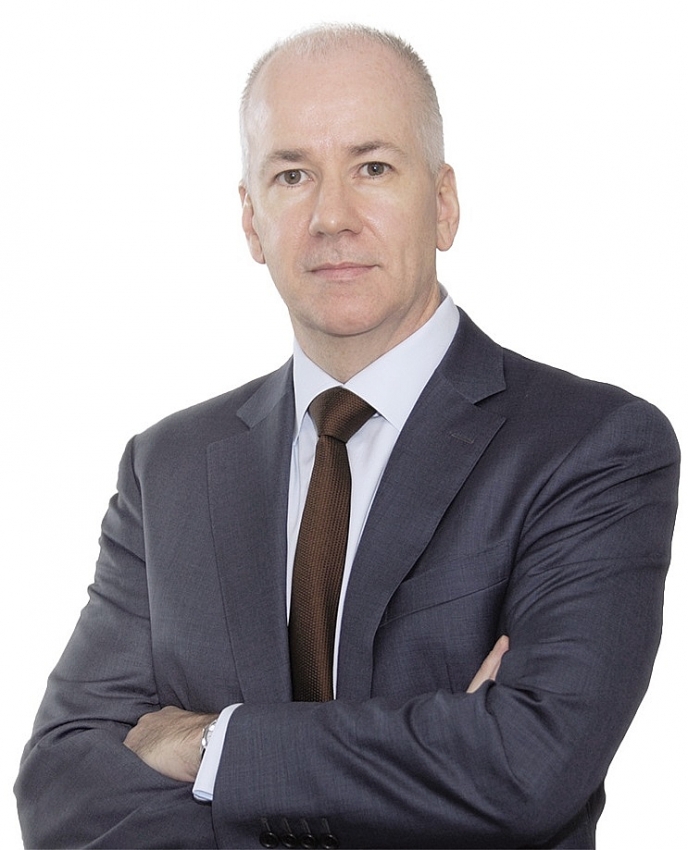Shaping connected enterprises to help attain effective growth
 |
| Ross Macallister - Managing partner, head of Consulting, KPMG Vietnam and Cambodia |
The Vietnamese marketplace is becoming increasingly competitive and brands are going to need to transform rapidly to meet evolving customer expectations. Disruption is becoming pervasive: challenging business models, legacy products, and entire industries. Even the most highly-regulated markets and companies here will not be immune.
Therefore, delivering on the customer imperative for a connected experience requires organisations to be responsive, resilient, and closer to their customers than ever before. The ability to understand and meet customer expectations is recognised worldwide as a primary driver of growth. To survive and thrive, Vietnamese organisations need to start developing a deeper understanding of the expectations of their customers – as well as the partners who engage those end-customers – and think about creating differentiated experiences that go beyond multichannel interactions.
These expectations need to span four key experience attributes:
• Brands must be perceived as trustworthy, attractive, and differentiated from their competition;
• Products and services must be relevant, transparent, and consistent;
• Customers’ interactions with a company must be personal, seamless, frictionless, and timely; and
• A company’s people must be truly customer-centric: knowledgeable, reliable, as well as empowered.
In general, Vietnamese businesses must take reference of the experiences of more developed markets and start to put the customer at the centre and elevate their experience as a competitive differentiator.
That means connecting to customers with compelling value propositions, opportunities, and interactions. It also means connecting the front, middle, and back offices to execute the customer growth agenda effectively and efficiently while also connecting and aligning with channel and business partners to jointly deliver on commitments to customers. Lastly, it means staying connected to market dynamics and digital signals.
Connected capabilities
KPMG refers to this level of maturity as the connected enterprise and it goes far beyond channel harmonisation. According to our research, high-performing organisations are getting connected by making significant investments across eight connected enterprise capabilities.
Product, pricing, and customer strategy: The ability to deliver relevant, valuable and consistent products, services, experiences, pricing, and offers that are targeted to their intended customer segments.
Experience-centricity: The ability to design and deliver a seamless and personal customer experience that continually meets evolving expectations across all physical and digital touchpoints to drive engagement, satisfaction, and loyalty. Experience-centricity applies to prospects, customers, employees, and partners.
Responsive supply chains: The ability for a customer to select, receive, and return products/services when, where, and how it is convenient for them and in a way that is enabled through advanced, analytics-driven demand planning, inventory management, and distribution.
Partnerships, alliances, and vendor management: The ability to effectively leverage third-party entities to increase speed to market, reduce costs, or supplement capability gaps to deliver on the customer promise.
Advanced data and analytics: The ability to harness and use data, analytics, and insights to engage and execute in a thoughtful and orchestrated manner across all touchpoints while also protecting customer data integrity, privacy, and security.
Technology architecture and enablement: The ability to leverage technology systems and expertise to effectively and efficiently deliver cross-channel experiences, provide employees with enabling tools, and synchronise with partners and the broader digital ecosystem.
Seamless commerce: The ability to deliver a convenient, secure transaction experience that meets customer preferences while ensuring payment technologies are integrated and provide a consistent experience across channels.
Organisational alignment and people capability: The ability for an organisation to marry outside-in customer perspectives with inside-out experience management processes and capabilities, including top-down executive vision, cultural alignment, and agile organisational structures.
KPMG is doing this to a greater degree than less mature organisations. These connected enterprises are able to understand what customers need and value, and they achieve it by delivering the intended experience profitably. They also have the responsiveness and resiliency to evolve with the changing consumer and competitive landscape to consistently deliver on their customer promise.
Ultimately, when it comes to capturing value, the work we do with our global clients shows that the connected enterprise enables organisations to better manage and modify expectations and deliver the right experience – at the optimum value.
That is, mature organisations are more successful at striking the right balance between what customers expect and what makes financial sense. They do it by mastering the economics of customer experience. Simply stated, enterprises need to manage both experience expectations and experience delivery and execution, recognising the power of the eight connected enterprise capabilities working together.
 |
| Getting the balance right between customer expectations and their actual experience is key for businesses to compete in an effective manner |
Becoming connected
Becoming a connected enterprise is an ongoing journey and the ability to consistently align the experience expectations with experience delivery will likely be the key challenge for Vietnamese businesses. This is because typically, in our experience, most businesses in Vietnam are focused on solving their front-office issues without aligning their middle and back offices to execute and deliver on their customer promise.
There are key steps required to develop your strategy. First, understand how you are performing today. Consider several dimensions – what your customers tell you about the services and products you are delivering to them. Are they satisfied? If not, where is the breakdown occurring? How is your organisation performing on each of the eight capabilities of a connected enterprise? To what extent is the business ensuring the capabilities are working together to provide a seamless experience for the customer?
Define the customer experience your business wants to deliver based on a clear understanding of their voice, the marketplace, including competitive and comparative practices and experiences, and the economics of these experiences on your existing and target customers.
Identify the necessary requirements for delivering the appropriate customer experience using the eight capabilities of a connected enterprise and understand where there are gaps in your company’s ability to execute today.
Develop a road map for closing the connected enterprise gaps. Create a detailed business case for each initiative, with clear links to desired value and required capabilities.
Finally, execute the plan and continually monitor your progress from your customers’ perspective, the economics of the experiences delivered, and your competitive positioning.
Building a connected enterprise can help navigate the challenges of digital disruption, compete effectively in the rapidly evolving Vietnamese marketplace, and ultimately drive profitable growth.
By Ross Macallister - Managing partner, head of Consulting, KPMG Vietnam and Cambodia
What the stars mean:
★ Poor ★ ★ Promising ★★★ Good ★★★★ Very good ★★★★★ Exceptional
Related Contents
Latest News
More News
- KPMG launches tariff modeller in Vietnam to navigate US tariff risks (July 29, 2025 | 12:11)
- Removing hidden barriers to unlock ASEAN trade (June 29, 2025 | 11:31)
- New report charts path for Vietnam’s clinical trial growth (May 21, 2025 | 08:58)
- TTC Agris strengthens market position with investment in Bien Hoa Consumer JSC (May 19, 2025 | 10:14)
- World Bank to help SBV build shared database for banking industry (April 09, 2025 | 08:55)
- New trade alliances and investment hubs are redefining global power dynamics (April 03, 2025 | 17:00)
- ACCA and KPMG forge path for business leaders to pioneer ESG excellence (March 07, 2025 | 10:09)
- VietBank signs MoU with KPMG (February 26, 2025 | 18:47)
- Warrick Cleine MBE: an honour for services to British trade and investment in Vietnam (December 31, 2024 | 20:16)
- KPMG report offers fresh insight into leveraging AI (December 24, 2024 | 09:23)

 Tag:
Tag:





















 Mobile Version
Mobile Version